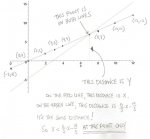You are using an out of date browser. It may not display this or other websites correctly.
You should upgrade or use an alternative browser.
You should upgrade or use an alternative browser.
another one I missed Help!!
- Thread starter Belby
- Start date
mmm4444bot
Super Moderator
- Joined
- Oct 6, 2005
- Messages
- 10,962
Belby said:y = 5/3x - 14/3 Your work is correct, up to this point.
Now, we have equations for two lines.
y = (5/3)x - 14/3
y = x
Since both of the righthand-side expressions above equal the same number (y), both of these expressions must equal one another at the point of intersection.
(5/3)x - 14/3 = x
You can find A and B from this equation. (Do you realize that A = B, since the intersection point (A, B) lies on the line y = x ?)
MY EDIT: Added clarification, and fixed transposition error.
mmm4444bot
Super Moderator
- Joined
- Oct 6, 2005
- Messages
- 10,962
Belby said:I'm totally lost.
I apologize; I could have been clearer.
We have two different lines. They intersect somewhere at a single point.
Since every point on the line y = x has equal x- and y-coordinates, the point of intersection with the other line must have equal x- and y-coordinates.
I'll upload an image, momentarily.
mmm4444bot
Super Moderator
- Joined
- Oct 6, 2005
- Messages
- 10,962
In the meantime, can you solve the following equation for x ?
(5/3)x - 14/3 = x
mmm4444bot
Super Moderator
- Joined
- Oct 6, 2005
- Messages
- 10,962
[attachment=0:3icfmd4g]4Belby.JPG[/attachment:3icfmd4g]
Double-click the image, to expand.
(Oh, the colors faded. The red line is the line with the labeled points.)
The red line is part of the graph of y = x .
The green line is part of the graph of y = (5/3)x - 14/3 .
Every point on the red line has coordinates (x, x).
At the point of intersection, the y-coordinate can be written two different ways.
It can be written as x.
It can be written as (5/3)x - 14/3.
There is only ONE y-coordinate at the point of intersection, so x must equal (5/3)x - 14/3 at that point.
Double-click the image, to expand.
(Oh, the colors faded. The red line is the line with the labeled points.)
The red line is part of the graph of y = x .
The green line is part of the graph of y = (5/3)x - 14/3 .
Every point on the red line has coordinates (x, x).
At the point of intersection, the y-coordinate can be written two different ways.
It can be written as x.
It can be written as (5/3)x - 14/3.
There is only ONE y-coordinate at the point of intersection, so x must equal (5/3)x - 14/3 at that point.
Attachments
mmm4444bot
Super Moderator
- Joined
- Oct 6, 2005
- Messages
- 10,962
Belby said:-4 Nope.
If you had shown your work, perhaps I could see how you got -4.
mmm4444bot
Super Moderator
- Joined
- Oct 6, 2005
- Messages
- 10,962
Belby said:(5/3)x-14/3=X
2/3-14/3=-4
Ah, I think I see the error.
When we subtract x from (5/3)x, we get (2/3)x, not 2/3.
\(\displaystyle \frac{5}{3} x - \frac{14}{3} = x\)
Subtract x from both sides.
\(\displaystyle \frac{5}{3} x - x - \frac{14}{3} = x - x\)
\(\displaystyle \left( \frac{5}{3} - \frac{3}{3} \right) x - \frac{14}{3} = 0\)
\(\displaystyle \frac{2}{3} x - \frac{14}{3} = 0\)
Now, add 14/3 to both sides.
\(\displaystyle \frac{2}{3} x + \frac{14}{3} - \frac{14}{3} = \frac{14}{3} + 0\)
\(\displaystyle \frac{2}{3} x = \frac{14}{3}\)
Multiply both sides by 3/2.
\(\displaystyle \frac{3}{2} \cdot \frac{2}{3} x = \frac{3}{2} \cdot \frac{14}{3}\)
\(\displaystyle x = 7\)
Belby, you are losing your time by trying to solve stuff like intersection points if you areBelby said:(5/3)x-14/3=X
2/3-14/3=-4
unable to solve such a basic equation.
It would be way to your advantage to back up some, and make sure you understand the basics....
mmm4444bot
Super Moderator
- Joined
- Oct 6, 2005
- Messages
- 10,962
Belby said:… I would have never gotten the correct answer.
Then this is an opportunity to learn something.
Do you now understand why A = 7 and B = 7 ?
If you're still unsure, we can certainly continue this discussion.

